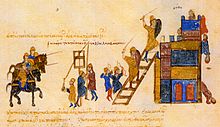John I Tzimiskes
| John I Tzimiskes | |
|---|---|
Theodora | |
| Dynasty | Macedonian |
John I Tzimiskes (
Background
John was born in present-day
Tzimiskes was born in 924 or 925, as Leo the Deacon states that he died aged 51,
Contemporary sources describe Tzimiskes as a rather short but well-built man, with reddish blonde hair and beard and blue eyes who was attractive to women.[15][16] He seems to have joined the army at an early age, originally under the command of his maternal uncle Nikephoros Phokas. The latter is also considered his instructor in the art of war. Partly because of his familial connections and partly because of his personal abilities, Tzimiskes quickly rose through the ranks. He was given the political and military command of the theme of Armenia before he turned twenty-five years old.
His marriage to Maria Skleraina, daughter of Pantherios Skleros and sister of Bardas Skleros, linked him to the influential Skleros family. Little is known about her; she died before his rise to the throne, and the marriage was apparently childless. The contemporary historian Leo the Deacon remarks that she excelled in both beauty and wisdom. [17]
Rise to the throne

The Byzantine Empire was
By 962 the Hamdanids had sued for peace with favorable terms for the Byzantines, securing the eastern border of the Empire for some years. Tzimiskes distinguished himself during the war both at the side of his uncle and at leading parts of the army to battle under his personal command, as in the Battle of Raban in 958.[18] He was rather popular with his troops and gained a reputation for taking the initiative during battles, turning their course.
On the death of Emperor Romanos II in 963, Tzimiskes urged his uncle to seize the throne. After helping Nikephoros to the throne and continuing to defend the Empire's eastern provinces, Tzimiskes was deprived of his command by an intrigue, for which he retaliated by conspiring with Nikephoros' wife Theophano and a number of disgruntled leading generals (Michael Bourtzes and Leo Balantes) to assassinate Nikephoros.
Reign

During his early reign he had to fight off the Kievan Rus' encroachment on the Lower Danube. In 970 he sent his brother-in-law, Bardas Skleros, to push the Rus' forces out of Thrace; Skleros defeated the Rus' army at Arcadiopolis. In 971, John Tzimiskes took the main army across Mt. Haemus, and besieged the fortress of Dorostolon (Silistra) on the Danube for 65 days, where after several hard-fought battles he defeated Grand Prince Sviatoslav I of Kiev. Tzimiskes and Sviatoslav ended up negotiating a truce, in which weaponry, armor and provisions were exchanged for the famished Rus' departure.
In 972, Tzimiskes turned against the
Death
Legacy
Tsimiski Street, the main commercial road in the center of Thessaloniki, is named after him. Çemişgezek in the Tunceli Province, modern day Turkey, is named after him, as he was born there.[citation needed]
See also
Notes
- ^ Leo the Deacon, pp. 143–147 (VI, 1–4).
- ^ "Çemişgezek" in The Concise Dictionary of World Place-Names, 2005, by John Everett-Heath, Oxford University Press.
- , retrieved 30 April 2023
- ^ Kazhdan 1991, pp. 1156–1157.
- ^ Andriollo 2012, p. 58.
- S2CID 218992750, retrieved 18 April 2023
- ^ Blaum 1994, p. 6. "The Phocas family was always associated with the province of Cappadocia in eastern Anatolia; its actual lineage seems to have been a mixture of Armenian and Greek.".
- ISBN 978-0-333-49601-5.
- ^ a b "John I (Roman emperor)". Encyclopædia Britannica.
- ^ Leo the Deacon, pp. 141–142 (V, 9).
- ^ (in Armenian) Matthew of Edessa. Մատթեոս Ուռհայեցի`Ժամանակնագրություն (The Chronicle of Matthew of Edessa). Translation and commentary by Hrach Bartikyan. Yerevan, Armenian SSR: Hayastan Publishing, 1973, pp. 12–13.
- ^ See Matthew of Edessa. The Chronicle of Matthew of Edessa, p. 301, note 52.
- ^ "Ioannes I. Tzimiskes". Prosopographie der mittelbyzantinischen Zeit Online (in German). De Gruyter. 2013. Retrieved 29 April 2023.
- ^ Leo the Deacon, p. 221 (X, 11).
- ^ Leo the Deacon, p. 146 (V, 3).
- ^ Treadgold 1997, pp. 505–506.
- ^ "Maria Skleraina". Prosopographie der mittelbyzantinischen Zeit Online (in German). De Gruyter. 2013. Retrieved 29 April 2023.
- ^ Shepard 2010, p. 151-152.
- ^ Romane 2015, p. 73.
- ^ a b Treadgold 1997, p. 512.
- ^ a b Norwich 1992, p. 229.
- ^ Leo the Deacon, p. 218 (X, 11).
Sources
- Andriollo, Lisa (2012), "Les Kourkouas (IXe-XIe siècle)", in Cheynet, Jean-Claude; Sode, Claudia (eds.), Studies in Byzantine Sigillography (in French), vol. 11, Berlin: De Gruyter, pp. 57–88, ISBN 978-3-11-026668-9
- ISBN 978-0-88402-324-1.
- Blaum, Paul A. (1994). The Days of the Warlords: A History of the Byzantine Empire, A.D. 969-991. ISBN 978-0-8191-9657-6.
- ISBN 0-19-504652-8.
- ISBN 978-3110151794.
- Romane, Julian (2015). Byzantium Triumphant. Pen and Sword Books. ISBN 978-1473845701.
- ISBN 0-8047-2630-2.
- This article incorporates text from a publication now in the public domain: Chisholm, Hugh, ed. (1911). "John I (Roman emperor)". Encyclopædia Britannica. Vol. 15 (11th ed.). Cambridge University Press. p. 438.
- OCLC 18164817.
- Shepard, Jonathan (2010). "Raban, Battle of". In Rogers, Clifford J. (ed.). The Oxford Encyclopedia of Medieval Warfare and Military Technology. Vol. 3:Merc-Zuri. Oxford University Press. pp. 151–152.
- Walker, Paul E. (1977). "The "Crusade" of John Tzimisces in the light of new Arabic evidence". Byzantion. 47: 301–327.


